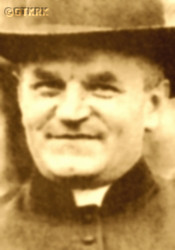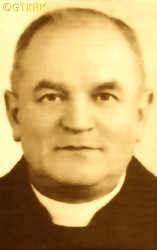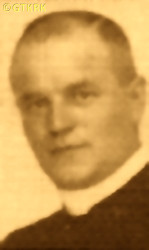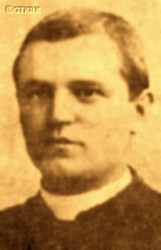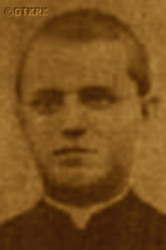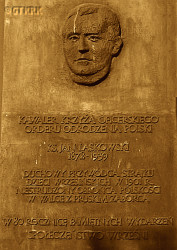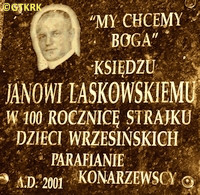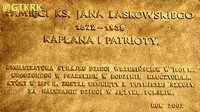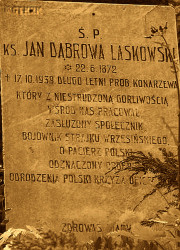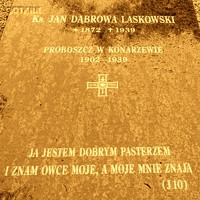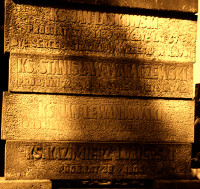Roman Catholic
St Sigismund parish
05-507 Słomczyn
85 Wiślana Str.
Konstancin deanery
Warsaw archdiocese, Poland
full list:
displayClick to display full list

searchClick to search full list by categories
wyświetlKliknij by wyświetlić pełną listę po polsku

szukajKliknij by przeszukać listę wg kategorii po polsku

Martyrology of the clergy — Poland
XX century (1914 – 1989)
personal data
surname
LASKOWSKI
forename(s)
John Dąbrowa (pl. Jan Dąbrowa)
function
diocesan priest
creed
Latin (Roman Catholic) Church RCmore on
en.wikipedia.org
[access: 2014.09.21]
diocese / province
Gniezno and Poznań archdiocese (aeque principaliter)more on
www.archpoznan.pl
[access: 2012.11.23]
RC Military Ordinariate of Polandmore on
en.wikipedia.org
[access: 2014.12.20]
honorary titles
„Polonia Restituta” Cross — 4th Class, Officer'smore on
en.wikipedia.org
[access: 2019.04.16]
(10.11.1928)
date and place
of death
17.10.1939

Konarzewotoday: Dopiewo gm., Poznań pov., Greater Poland voiv., Poland
more on
en.wikipedia.org
[access: 2021.12.19]
details of death
While serving as a vicar in his first parish in Wieluń, allegedly fell afoul of the partitioning Prussian authorities — his parish was located in the Germ. Provinz Posen (Eng. Poznań Province), part of the Germ. Königreich Preußen (Eng. Kingdom of Prussia), which was part of the Germ. Deutsches Kaiserreich (Eng. German Empire) — by giving religious education classes and delivering sermons in Polish. Therefore, in 02.1898, after two years, disciplinarily — according to some sources — transferred to Września.
There, when on 04.03.1901 a new regulation reached the local primary school, ordering — from the new school year, starting on 01.04.1901 — religious education to be taught in German, the children refused to accept the new catechisms (or returned them the next day). The Prussian authorities began to apply punishments against the protesters, including flogging. Gave support to the children and their families at that time, becoming the spiritual leader of the protest. When the district school inspector, a German, appeared at the school on 20.05.1920, ordered the children of the local Germ. Katholische Volksschule (Eng. Catholic People's School) to „finally learn the church song 'Who will entrust' in German”. When 14 children refused, they were punished by the German teachers by flogging. The parents protested. In the report on the incident, the inspector stated: „The soul of the entire agitation is the local priest vicar Laskowski […] I ask you to cause his removal from Września”. Appeared — as a witness and defender of the accused children — before the Second Criminal Chamber of the Royal Land Court in Gniezno. For participating in the strike, at the trial on 14‐11.11.1901 in Gniezno, the Germans sentenced 25 people from a fine to 2.5 years in prison. The court also renewed demand to remove him from Września. Half a year later, on 05.06.1902, the German Emperor, William II Hohenzollern, gave a speech in Malbork, in which he said: „Polish impudence and Sarmatian arrogance threaten Germanness […] I call on all of you, knights of the German Order, to a holy war [against them]”. This, among others, led to a whole wave of school strikes in the Prussian partition of Poland. Their culmination was a general strike in 1906 — at its peak, about 75,000 children went on strike in about 800 schools (out of a total of 1,100 schools).
In Konarzewo, where was transferred on 15.01.1902, ministered as an administrator — the Prussian authorities did not allow him to be granted the rights of a parish priest, calling him until the end of German rule in Greater Poland Germ. „Herr Vicar zu Konarzewo”.
After the abdication on 09.11.1918 of the German Emperor William II Hohenzollern; after the signing on 11.11.1918 by the Allies and the Germans, in a staff wagon in Compiègne, at the headquarters of French Marshal Ferdinand Foch, of an armistice and ceasefire — which de facto meant the end of World War I; and also after the transfer on 11.11.1918 by the Regency Council — operating in the so‐called Germ. Königreich Polen (Eng. Polish Kingdom), i.e. the territory occupied by the Central Powers (Germany and Austria–Hungary) — of supreme military authority to Brigadier Joseph Piłsudski and appointing him Commander‐in‐Chief of the Polish Army, which de facto meant the rebirth of the Polish state, however, covering only the Germ. Königreich Polen, i.e. the Polish territory under Russian rule until 1915, and excluding the lands of the Prussian partition; the Greater Poland — i.e. the Prussian Germ. Provinz Posen — was still formally part of the German state. Began then to cooperate with the Polish District People's Council established on 12.11.1918 in the Germ. Landkreis Posen–West (Eng. District of Poznań West), and in particular with the People's Guard organised by it. When the Greater Poland Uprising broke out on 27.12.1918, in nearby Dopiewo — with a station on the strategic Poznań–Berlin railway line — an 800‐strong district insurgent unit was organised, which many of his parishioners joined. The school in Konarzewo was transformed into insurgent barracks. Established contact with the Red Cross organization, while maintaining constant contact with the Commissariat of the Supreme People's Council NRL, recognized by the Polish District Parliament (Seym), which met in Poznań on 03‐05.12.1918, as the sole and legal authority of Poles in Germany. On 05.01.1919 in Konarzewo celebrated a field mass for 516 insurgents. The unit became famous for participating on 06.01.1919 in the capture of Ławica near Poznań and the military airport located there — and the largest war booty in the history of Polish arms (among others over 300 aircraft). Next, until the end of the uprising, organized help for the fighters, sending two wagons of food and one wagon of hay.
After German invasion of Poland in 09.1939 and start of the World War II, perished — according to some sources — during search of his rectory, subsequent interrogation and arrest attempt by the Germans, at the start of German occupation.
cause of death
heart attack
perpetrators
Germans
sites and events
«Intelligenzaktion»Click to display the description, Ribbentrop‐MolotovClick to display the description, Pius XI's encyclicalsClick to display the description, Greater Poland UprisingClick to display the description
date and place
of birth
22.06.1872

Psarskietoday: Pniewy gm., Szamotuły pov., Greater Poland voiv., Poland
more on
en.wikipedia.org
[access: 2021.07.18]
parents
LASKOWSKI Joseph Alexander
🞲 1842, ? — 🕆 1928, ?

WILHELMI Julia Claire
🞲 ?, ? — 🕆 ?, ?
presbyter (holy orders)
ordination
25.02.1896

Gnieznotoday: Gniezno urban gm., Gniezno pov., Greater Poland voiv., Poland
more on
en.wikipedia.org
[access: 2021.12.18]
positions held
22.04.1920 – 1939
parish priest — Konarzewotoday: Dopiewo gm., Poznań pov., Greater Poland voiv., Poland
more on
en.wikipedia.org
[access: 2021.12.19] ⋄ St Martin the Bishop and Confessor RC parish ⋄ Buktoday: Buk gm., Poznań pov., Greater Poland voiv., Poland
more on
en.wikipedia.org
[access: 2021.06.20] RC deanery
1902 – 1920
administrator — Konarzewotoday: Dopiewo gm., Poznań pov., Greater Poland voiv., Poland
more on
en.wikipedia.org
[access: 2021.12.19] ⋄ St Martin the Bishop and Confessor RC parish ⋄ Buktoday: Buk gm., Poznań pov., Greater Poland voiv., Poland
more on
en.wikipedia.org
[access: 2021.06.20] RC deanery — by the partitioning Prussian authorities regarded as Germ. „Herr Vicar zu Konarzewo”
1898 – 1902
vicar — Wrześniatoday: Września gm., Września pov., Greater Poland voiv., Poland
more on
en.wikipedia.org
[access: 2021.06.20] ⋄ Assumption of the Blessed Virgin Mary and St Stanislav the Bishop and Martyr RC parish ⋄ Gniezno Holy Trinitydeanery name
today: Gniezno urban gm., Gniezno pov., Greater Poland voiv., Poland
more on
en.wikipedia.org
[access: 2021.12.18] RC deanery
1896 – 1898
vicar — Wieleńtoday: Wieleń gm., Czarnków/Trzcianka pov., Greater Poland voiv., Poland
more on
en.wikipedia.org
[access: 2021.07.18] ⋄ Blessed Virgin Mary of the Assumption RC parish ⋄ Czarnkówtoday: Czarnków gm., Czarnków/Trzcianka pov., Greater Poland voiv., Poland
more on
en.wikipedia.org
[access: 2021.06.20] RC deanery
1895 – 1896
student — Gnieznotoday: Gniezno urban gm., Gniezno pov., Greater Poland voiv., Poland
more on
en.wikipedia.org
[access: 2021.12.18] ⋄ philosophy and theology, Archbishop's Practical Theological Seminary (Lat. Seminarium Clericorum Practicum)
1892 – 1895
student — Poznańtoday: Poznań city pov., Greater Poland voiv., Poland
more on
en.wikipedia.org
[access: 2021.07.18] ⋄ philosophy and theology, Archbishop's Theological Seminary (Collegium Leoninum)
sites and events
descriptions
«Intelligenzaktion»: German: «Intelligenzaktion» (English: „Intelligence Action”) — a German program of extermination of the Polish elite, mainly the intelligentsia and leadership layers, carried out from the beginning of the occupation in w 09.1939 to 04.1940, mainly in territories directly annexed to Germany, but also in the so‐called Germ. Generalgouvernement (Eng. General Governorate), where it was called «AB‐aktion». In the first phase, immediately after the beginning of the German occupation, during military operations carried out by the Germ. Wehrmacht (Eng. Armed Forces) and the genocidal units of the Germ. Einsatzgruppen (Eng. Operational Groups) of the Germ. Sicherheitspolizei (Eng. Security Police), i.e. SiPo, and Germ. Sicherheitsdienst des Reichsführers SS (Eng. Security Service of the Reichsführer SS), i.e. SD, organized by the Germ. Reichssicherheitshauptamt (Eng. Reich Main Security Office), i.e. RSHA, which followed the troops, carried out under the Germ. Unternehmen „Tannenberg” (Eng. Operation „Tannenberg”) — based on the so‐called Germ. Sonderfahndungsliste (Eng. Special Wanted Lists), i.e. proscription lists of Poles considered particularly dangerous to the Third Reich, prepared by the Zentralstelle II/P (Polen) unit of the German RSHA. Later, implemented by the German civilian occupation authorities and the genocidal unit of the Germ. Volksdeutscher Selbstschutz (Eng. Ethnic Germans Self‐Defense), whose members were Germ. Volksdeutsche (Eng. Ethnic Germans), i.e. representatives of the German minority in Poland. According to various sources, these lists, at the beginning of 09.1939, could have contained the details of 61,000—88,000 „dangerous” Poles — although these figures cannot be confirmed. In total, during this genocide, c. 50,000 teachers, Catholic priests, representatives of the landed gentry, freelancers, social and political activists, and retired military personnel were systematically and methodically murdered. Another 50,000 were sent to concentration camps, where only a negligible percentage survived. (more on: en.wikipedia.orgClick to attempt to display webpage
[access: 2014.10.04])
Ribbentrop‐Molotov: Genocidal Russian‐German alliance pact between Russian leader Joseph Stalin and German leader Adolf Hitler signed on 23.08.1939 in Moscow by respective foreign ministers, Mr. Vyacheslav Molotov for Russia and Joachim von Ribbentrop for Germany. The pact sanctioned and was the direct cause of joint Russian and German invasion of Poland and the outbreak of the World War II in 09.1939. In a political sense, the pact was an attempt to restore the status quo ante before 1914, with one exception, namely the „commercial” exchange of the so‐called „Kingdom of Poland”, which in 1914 was part of the Russian Empire, fore Eastern Galicia (today's western Ukraine), in 1914 belonging to the Austro‐Hungarian Empire. Galicia, including Lviv, was to be taken over by the Russians, the „Kingdom of Poland” — under the name of the General Governorate — Germany. The resultant „war was one of the greatest calamities and dramas of humanity in history, for two atheistic and anti‐Christian ideologies — national and international socialism — rejected God and His fifth Decalogue commandment: Thou shall not kill!” (Abp Stanislav Gądecki, 01.09.2019). The decisions taken — backed up by the betrayal of the formal allies of Poland, France and Germany, which on 12.09.1939, at a joint conference in Abbeville, decided not to provide aid to attacked Poland and not to take military action against Germany (a clear breach of treaty obligations with Poland) — were on 28.09.1939 slightly altered and made more precise when a treaty on „German‐Russian boundaries and friendship” was agreed by the same murderous signatories. One of its findings was establishment of spheres of influence in Central and Eastern Europe and in consequence IV partition of Poland. In one of its secret annexes agreed, that: „the Signatories will not tolerate on its respective territories any Polish propaganda that affects the territory of the other Side. On their respective territories they will suppress all such propaganda and inform each other of the measures taken to accomplish it”. The agreements resulted in a series of meeting between two genocidal organization representing both sides — German Gestapo and Russian NKVD when coordination of efforts to exterminate Polish intelligentsia and Polish leading classes (in Germany called «Intelligenzaktion», in Russia took the form of Katyń massacres) where discussed. Resulted in deaths of hundreds of thousands of Polish intelligentsia, including thousands of priests presented here, and tens of millions of ordinary people,. The results of this Russian‐German pact lasted till 1989 and are still in evidence even today. (more on: en.wikipedia.orgClick to attempt to display webpage
[access: 2015.09.30])
Pius XI's encyclicals: Facing the creation of two totalitarian systems in Europe, which seemed to compete with each other, though there were more similarities than contradictions between them, Pope Pius XI issued in 03.1937 (within 5 days) two encyclicals. In the „Mit brennender Sorge” (Eng. „With Burning Concern”) published on 14.03.1938, condemned the national socialism prevailing in Germany. The Pope wrote: „Whoever, following the old Germanic‐pre‐Christian beliefs, puts various impersonal fate in the place of a personal God, denies the wisdom of God and Providence […], whoever exalts earthly values: race or nation, or state, or state system, representatives of state power or other fundamental values of human society, […] and makes them the highest standard of all values, including religious ones, and idolizes them, this one […] is far from true faith in God and from a worldview corresponding to such faith”. On 19.03.1937, published „Divini Redemptoris” (Eng. „Divine Redeemer”), in which criticized Russian communism, dialectical materialism and the class struggle theory. The Pope wrote: „Communism deprives man of freedom, and therefore the spiritual basis of all life norms. It deprives the human person of all his dignity and any moral support with which he could resist the onslaught of blind passions […] This is the new gospel that Bolshevik and godless communism preaches as a message of salvation and redemption of humanity”… Pius XI demanded that the established human law be subjected to the natural law of God , recommended the implementation of the ideal of a Christian state and society, and called on Catholics to resist. Two years later, National Socialist Germany and Communist Russia came together and started World War II. (more on: www.vatican.vaClick to attempt to display webpage
[access: 2023.05.28], www.vatican.vaClick to attempt to display webpage
[access: 2023.05.28])
Greater Poland Uprising: Military insurrection of Poles of former German Germ. Posen Provinz (Eng. Poznań province) launched against German Reich in 1918‐1919 — after the abdication on 09.11.1918 of the German Emperor William II Hohenzollern; after the armistice between the Allies and Germany signed on 11.1.1918 in the HQ wagon in Compiègne, the headquarters of Marshal of France Ferdinand Foch — which de facto meant the end of World War I — against the German Weimar Republic, established on the ruins of the German Empire, aiming to incorporate lands captured by Prussia during partitions of Poland in XVIII century into Poland. The Republic of Poland, reborn on 11.11.1918, initially formally included only the so‐called Germ. Königreich Polen (Eng. Kingdom of Poland), i.e. the territory that had been under Russian rule until 1915 and then under the control of Central States (Germany and Austria–Hungary), but did not include the Prussian partition. Started on 27.12.1918 in Poznań and ended on 16.02.1919 with the armistice pact in Trier, forced by the victorious Entente states, which included provisions ordering Germany to cease operations against Poland and, importantly, recognizing the Polish insurgent Greater Poland Army as an allied armed force of the Entente. De facto it turned out to be a Polish victory, confirmed in the main peace treaty after World War I, the Treaty of Versailles of 28.06.1919, which came into force on 10.01.1920 and in which most of the lands of the Prussian partition were recognized as Polish. Many Polish priests took part in the Uprising, both as chaplains of the insurgents units and members and leaders of the Polish agencies and councils set up in the areas covered by the Uprising. In 1939 after German invasion of Poland and start of the World War II those priests were particularly persecuted by the Germans and majority of them were murdered. (more on: en.wikipedia.orgClick to attempt to display webpage
[access: 2016.08.14])
sources
personal:
www.wtg-gniazdo.orgClick to attempt to display webpage
[access: 2012.11.23], pl.wikipedia.orgClick to attempt to display webpage
[access: 2012.11.23], www.mojekonarzewo.plClick to attempt to display webpage
[access: 2016.05.30], www.parafiakonarzewo.plClick to attempt to display webpage
[access: 2016.05.30]
original images:
www.katakumbus.plClick to attempt to display webpage
[access: 2016.05.30], www.csw2020.com.plClick to attempt to display webpage
[access: 2024.12.13], www.csw2020.com.plClick to attempt to display webpage
[access: 2024.12.13], www.csw2020.com.plClick to attempt to display webpage
[access: 2024.12.13], blogmedia24.plClick to attempt to display webpage
[access: 2015.09.30], www.ssp-2.wrzesnia.plClick to attempt to display webpage
[access: 2016.05.30], commons.wikimedia.orgClick to attempt to display webpage
[access: 2014.01.06], dopiewo.plClick to attempt to display webpage
[access: 2024.12.13], regionszamotulski.plClick to attempt to display webpage
[access: 2024.12.13], www.wtg-gniazdo.orgClick to attempt to display webpage
[access: 2012.11.23], www.parafiakonarzewo.plClick to attempt to display webpage
[access: 2016.05.30], www.wtg-gniazdo.orgClick to attempt to display webpage
[access: 2012.11.23]
LETTER to CUSTODIAN/ADMINISTRATOR
If you have an Email client on your communicator/computer — such as Mozilla Thunderbird, Windows Mail or Microsoft Outlook, described at WikipediaPatrz:
en.wikipedia.org, among others — try the link below, please:
LETTER to CUSTODIAN/ADMINISTRATORClick and try to call your own Email client
If however you do not run such a client or the above link is not active please send an email to the Custodian/Administrator using your account — in your customary email/correspondence engine — at the following address:

giving the following as the subject:
MARTYROLOGY: LASKOWSKI John Dąbrowa
To return to the biography press below:
 Click to return to biography
Click to return to biography








